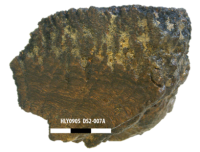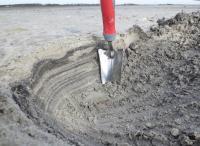On This Page:
Types of Marine Minerals
When it comes to the type of marine mineral deposits that might comprise critical minerals, there are five main categories: manganese nodules, ferromanganese crusts, hydrothermal deposits, nearshore minerals, and phosphorites.
Polymetallic Nodules
Polymetallic nodules are manganese concretions, rounded and about the size of a potato, found on the seafloor.
- Typical Water Depth: 4,000 to 7,000 meters
- Occurrence: Nodules occur on or near the top of soft sediments of abyssal plains
- Habitat: Deep sea corals, worms, and crustaceans
- Location: All ocean basins, most abundant in central Pacific
- Growth Rate: 2-10 mm / million years
- Minerals: Nickel, copper, cobalt, manganese, rare earth elements, possibly titanium, tellurium, lithium
Ferromanganese Crusts
Ferromanganese Crusts are layered, cobalt-rich encrustations forming on rocks, typically less than 25 cm thick.
- Typical Water Depth: 600 to 7,000 meters
- Occurrence: Sides and summit of seamounts
- Habitat: Crusts are potential hard substrate for deep water corals and other sessile organisms; seamount ecosystems host fish, crustacean, and other fauna
- Location: Most extensive in central and western Pacific
- Growth Rate: 1-4 mm / million years
- Minerals: Manganese, cobalt, nickel, copper, rare earth elements, possibly tellurium, scandium, platinum
Polymetallic Sulfide Deposits
Hydrothermal deposits, also known as seafloor massive sulphides, are formed from hot waters emanating from fractures in the Earth’s crust.
- Typical Water Depth: 100 to 7,000 meters
- Occurrence: Undersea volcanoes and mid-ocean spreading centers
- Habitat: Active hydrothermal vents host vent-fluid dependent animals including snails, crustaceans, and worms
- Location: Globally along active tectonic boundaries
- Growth Rate: Variable, but up to approximately 2 cm / day
- Minerals: Copper, zinc, gold, silver, and potentially antimony, bismuth, gallium, tellurium, germanium
Heavy Mineral Sands
Nearshore mineral include placers, which are heavy minerals concentrated by moving water, and offshore extensions of continental deposits.
- Typical Water Depth: Less than 200 meters
- Occurrence: Continental margins
- Habitat: Soft sediment (e.g., sand, mud) with burrowing invertebrates and bottom-dwelling fish
- Location: Close to terrestrial mineral deposits
- Minerals (Critical Minerals in Bold): Titanium, tin, platinum, gold, silver, and rare earth elements
Phosphorites
Phosphorites are a sedimentary rock containing a high proportion of calcium phosphate.
- Typical Water Depth: Less than 1,000 meters
- Occurrence: Along continental shelves and slopes, also comingled with crusts on seamounts
- Habitat: Hard surface possibly populated by sponges and corals
- Location: Atlantic and Pacific continental margins and seamounts
- Minerals: Phosphorous, rare earth elements, possibly uranium
Top 50 Critical Minerals
The following is a list of 50 minerals recognized as critical as of February 24, 2022. Current information about these minerals is provided by the National Minerals Information Center. Highlighted critical minerals occur in the marine environment of the U.S. Continental Shelf.
Critical Minerals Occurring Offshore
The US OCS has deposits of critical minerals used in transportation (lithium, cobalt, manganese) and defense & national security (germanium, rare earth elements). The following critical minerals are all found in the U.S. continental shelf.
Critical Minerals
- Antimony
- Bismuth
- Cobalt
- Gallium
- Germanium
- Lithium
- Magnesium
- Manganese
- Nickel
- Niobium
- Tellurium
- Tin
- Titanium
- Vanadium
- Zinc
- Zirconium
Platinum Group Metals
- Iridium
- Palladium
- Platinum
- Rhodium
- Ruthenium
Rare Earth Elements
- Scandium
- Yttrium
- Lanthanum
- Cerium
- Praseodymium
- Neodymium
- Samarium
- Europium
- Gadolinium
- Terbium
- Dysprosium
- Holmium
- Erbium
- Thulium
- Ytterbium
- Lutetium
Other critical minerals not in the US OCS:
Other marine minerals not within the U.S. OCS: Aluminum, Arsenic, Barite, Beryllium, Cesium, Chromium, Fluorspar, Graphite, Hafnium, Indium, Rubidium, Tantalum, and Tungsten.








